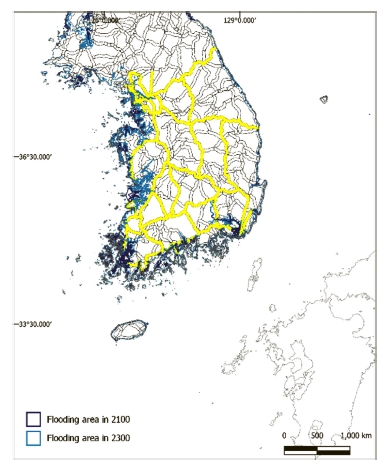
Risk Evaluation of Korean Coastal Areas Due to Sea Level Rising by Climate Change


Abstract
The ongoing effects of climate change continue to impact the world, with the problem becoming more serious at an exponentially increasing pace in recent years. Despite the seriousness of climate change, current practical responses are still insufficient due to a lack of political will to address the real risks. This study utilized altitude and expected rising sea level data to evaluate the risk of climate change on Korea’s coastline, identify flooded areas, and predict the population of affected people. In addition, this study also analyzed the damage to developed and rural areas and the cost of social overhead capital based on the aforementioned flooded areas. Studies have shown that the Korean coast is more vulnerable to sea level rise due to climate change in densely populated areas, urbanized areas, and farmland areas. A majority of these areas are located around the coast, which leaves them and the coastal road network more susceptible to potential flooding. In addition, it has been predicted that 48.9 percent of the basic unit of local governments in the Korean administrative district could be affected by flooding due to sea level rise. Based on these research results, a proposal was made to curtail residential migration towards more highly populous areas and increase road networks to cope with the climate change effects along the coast, with adaptation measures to suit the circumstances of unique local governments. The results of this study are expected to contribute to basic studies for further complex risk assessment studies, including research on additional climate change risks and optimal response studies linking human living environments with natural ecosystems.
초록
기후 변화의 영향은 최근 몇 년 동안 급격하게 증가하면서 세계의 모든 지역에 지속적으로 영향을 미치고 있다. 기후 변화의 심각성에도 불구하고, 현재의 실질적인 대응은 실제 위험을 해결하려는 정치적 의지의 부족으로 인해 여전히 불충분하다. 본 연구는 고도 및 해수면 상승 예상 자료를 활용하여 우리나라 해안선의 기후변화 위험도를 평가하고, 침수지역을 파악하며, 피해인구를 예측하였다. 또한 본 연구는 앞서 언급한 침수지역을 기준으로 개발지역 및 농촌지역의 피해와 사회간접자본의 피해를 각각 분석하였다. 우리나라 해안은 인구밀집지역, 도시화지역, 농경지 등에서 기후변화로 인한 해수면 상승에 더욱 취약하다는 연구결과가 나왔다. 이 지역들의 대부분은 해안 주변에 위치해 있기 때문에 해안 도로망이 잠재적인 홍수에 더욱 취약하다. 또한 우리나라 행정구역 내 기초자치단체 단위 중 48.9%가 해수면 상승에 따른 침수 피해를 입을 수 있다는 전망이 나왔다. 이러한 연구결과를 바탕으로 해안가 기후변화 영향에 대응하기 위해 인구밀집지역으로의 주거이동을 줄이고 도로망을 확충하여 고유한 지방자치단체의 실정에 맞는 적응방안을 제시하였다. 이 연구결과는 추가적인 기후변화위험에 대한 연구, 인간의 생활환경과 자연생태계를 연계한 최적대응 연구 등 더욱 복합적인 위험평가 연구를 위한 기초연구에 기여할 것으로 기대된다.
Keywords:
Climate Change, Sea Level Rise, Flooding of Coast Area, Risk Evolution of Climate Change, Adaptation Measures to Climate Change키워드:
기후변화, 해수면 상승, 해안지역 침수, 기후변화 위험평가, 기후변화 적응방안1. Introduction
Climate change has been scientifically proven in many areas and appears to be a reality that can no longer be denied (IPCC [2007]; IPCC [2013]). As of present, the global average temperature has risen by approximately 0.8℃ to 1.2℃ compared to the pre-industrialization era and has been increasing by 1.1℃ every 10 years (IPCC [2018]). Accordingly, climate change is recognized as one of the most critical and immediate global environmental threats.
Since the adoption of the United Nations Convention on Climate Change (UNFCCC) in 1992 as an effort to respond to climate change, efforts have been made to reduce greenhouse gases through the adoption of the Kyoto Protocol and the Paris Agreement (UN and Canada [1992]; UN [1997]]; UN [2015]). The Paris Agreement stipulates that all countries must respond to climate change and strive to restrict temperature increases to a ceiling of 1.5℃. Despite these efforts, however, climate change is still accelerating. A Special Report: Global Warming of 1.5℃ (IPCC [2018]) predicted that the period of temperature increase of 1.5℃ would be from 2030 to 2052, but the Sixes Assessment Report of IPCC [2021] indicated that if the current level of greenhouse gas emissions were maintained, the temperature increase would surpass 1.5℃ in 2021.
Despite this accelerating risk of climate change, few feasible and realistic mitigation solutions have been implemented. This is likely in part due to the minimal recognition of the effects of climate change on a day-to-day level. Citizens may only be aware on a theoretical level of the need to respond to climate change and as such are not inclined to take significant actions to cope with climate threats (Giddens [2009]). This apparent lack of urgency can provide a potential explanation for the unchecked growing dangers of climate change and sea level rise, as the average citizen is not cognizant of the quantified risks that occur around them. Most of the dangers of climate change are described by physical quantities such as air temperature and water temperature rise, precipitation fluctuations, sea level rise, etc.. (Kang [1994]; KEI [2002]), or vulnerability to climate change (Choi et al. [2009]; Lee et al. [2015]).
Despite the urgency of environmental risk for Korea, there has been limited exploration into the subsequent effects of climate change on vulnerability characteristics. This study will attempt to broaden the research scope of such characteristics to the size of flooded areas, the number of relevant affected victims, damage to developed and rural regions, and damage to social overhead capital in Korea. The insights gained from identifying these vulnerability characteristics of the Korean coastal environment to climate change are utilized to suggest countermeasures. This study analyzes the area of flooded areas, the number of victims of flooded areas, damage to the developed regions and the rural regions, and damage to social overhead capital due to climate change in Korea. It also evaluates the risk of climate change in the coastal environment. In addition, this study analyzes the vulnerability characteristics of the Korean coastal environment to climate change and suggests countermeasures.
2. Data & Methodology
In this study, coastal environmental damage due to climate change is assessed as the area of the flooded region, the number of residents affected by the sea level rise, the area of flooded development regions, the area of flooded farmland, the area of pasture regions, and the length of the road network in the flooded regions. To conduct relevant analyses, the data from the following datasets of interest have been used: Korean terrain elevation, Korean coastline, Korean population distribution, Korean development area distribution, Korean farmland distribution, Korean pasture land distribution, Korean administrative district distribution, and Korean road network distribution.
The Korean Peninsula Digital Elevation Model (KPDEM) 90 m data (KNGII [2020]), produced by the Korea National Geographic Information Institute (KNGII), is used for the Korean terrain elevation data. The KPDEM 90m data (KNGII [2020]) is an upgraded version of the near-global 90m evaluation (NGE 90 m) data (CGIAR-CSI [2008]), made from the Shuttle Radar Topography Mission (SRTM) of the National Aeronautics and Space Administration (NASA). The KPDEM 90 m data (KNGII [2020]) are up-to-date compared to the NGE 90 m data (CGIAR-CSI [2008]), and the units of evaluation value is 0.001 m, which is more precise than the NGE 90 m data in units of 1 m. The KPDEM 90 m data (KNGII [2020]) is raster data from the GeoTiff format.
Korea Coastline (KCL) data (KOHA [2021]) are vector data of a shape format composed of lines. In this study, coastline data were used to classify land areas, and for this purpose, data composed of lines were combined with a polygon. Coastline vectors were resampled at 5 m intervals using QGIS and reconstructed into 1:5,000 scale data to standardize the scale of coastline data.
The data on the distribution of the Korean population and the distribution of Korean development areas were produced jointly by the European Commission’s Joint Research Center (EC JRC) and the Columbia University’s Center for International Earth Science Information Network (CU CIESIN) Global Human Settlement Layer (GHSL): Population and Built-Up Esthetics, Deployment. GHSL data (EC JRC and CU CIESIN [2021]) are divided into nine arc-second grids (approx. 0.08 km2 at the equator) to construct data such as population distribution, building area ratio, and urbanization grade. GHSL data (EC JRC and CU CIESIN [2021]) consist of population counts (habitants/grid cells) per grid cell as the data from the year 2015, and development area distribution data consist of % of build-up areas per grid cell as of the year 2014. GHSL data (EC JRC and CU CIESIN [2021]) are raster data from the GeoTiff format.
The historical database of the Global Environment (HYDE) 3.2 data (PBL NEAA[2017]) produced by the Netherlands Environmental Assessment Agency (NEAA) are used as data on the distribution of Korean agricultural land and pastures. HYDE 3.2 data (PBL NEAA [2017]) are a global population distribution and land use grid (approx. 85 km2 at the equator) for about 12,000 years from BC10000 to AD 2017. In this study, data from AD 2017 were used. The distribution of agricultural land in 2017 consisted of total cropland area (km2/grid cell) per grid cell. The 2017 pasture distribution data are grazing 2017AD, consisting of total land used for grazing (km2/grid cell) per grid cell. HYDE 3.2 data (PBL NEAA [2017]) are raster data in ascii format.
Data on the distribution of administrative districts in Korea use 3.6 data (UCB MVZ and IRRI [2018]), which are co-produced by the Museum of Vertebrate Zoology of Berkeley (UCB MVZ) and the International Rice Research Institute (IRRI). Global Administrative Areas (GADM) data (UCB MVZ and IRRI [2018]) consist of a global administrative district boundary database and support download by country from data-providing sites. In this study, <South Korea> was selected from the data-providing site, and the boundaries of administrative districts in Korea were downloaded and used. GADM data (UCB MVZ and IRRI [2018]) are vector data in a shape format composed of polygons.
Concerning Korea’s road network distribution data, the study used Global Roads Open Access Data Set, Version 1 (GROADSv1) data (CU CIESIN and UGITOS [2013]), jointly produced by Columbia University’s Center for International Earth Science Information Network and the University of Georgia’s Information Technology Outlook Services (UG ITOS). The GROADSv1 data (CU CIESIN and UG ITOS [2013]) have been built for the entire globe and downloading data split by regions such as Africa, America, Asia, Europe, Oceania East, and Oceania West, etc., is supported the data-providing websites. The GROADSv1 data (CU CIESIN and UG ITOS [2013]) are vector data in a shape format consisting of lines.
3. Analysis of Coastal Environmental Damage
The environmental damage in the coastal regions due to climate change is analyzed by calculating the area of flooded areas due to sea-level rise, the number of residents affected by flooded areas, the area of damaged agricultural land, the area of damaged administrative districts, and the length of the road network.
Each of the following datasets – the KPDEM 90 m data (KNGII [2020]), KCL data (KOHA [2021]), GHSL data (EC JRC and CU CIESIN [2021]), HYDE 3.2 data (PBL NEAA [2017]), GADM data (UCB MVZ and IRRI [2018]), and GROADSv1 data (CUCIIN [2013]) – used in this study consists of an individual coordinate system according to its unique datum and projection. A self-numerical analysis of these data was performed in consideration of the accuracy loss caused by coordinate transformation, and the mutual comparison analysis of the data was converted into a unified standard coordinate system for overlapping analysis of maps. The standard coordinate system adopted in this study is the “WGS84 datum EPSE:4326” coordinate system (Table 1).
This study selected areas from [124E, 31N] to [132E, 39N]. For the numerical analysis of the data, a vector grid area were created, and the data of the target area were extracted and used. A comparative analysis of the data and presentation of the results were used by clipping the target area in a unified standard coordinate system.
The flooded areas resulting from sea level rise due to climate change were calculated by applying the sea level rise value due to climate change to the current high distribution KPDEM 90 m data (KNGII [2020]). The KPDEM 90 m data (KNGII [2020]) has an altitude value in the range of 0.00 m to 2650.68m as a real variable for land and a fill value of "0" as an integer variable for sea. In this study, the altitude data were removed from the KPDEM 90 m data (KNGII [2020]) using GDAL Raster analysis’s raster calibrator, and only land altitude data were used. The altitude distribution of the target areas [124E, 31N] to [132E, 39N] of this study, from which the sea area was removed from the KPDEM 90 m data (KNGII [2020]), is shown in Fig. 1.
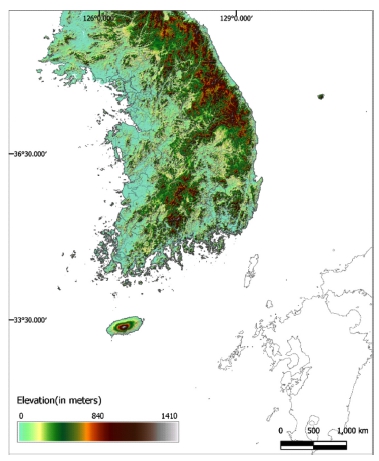
Korean coastline (data source: KOHA [2021]) and inland altitude distribution of shaded relief map (data source: KNGGII [2020]).
Due to climate change, the average sea level off the coast of Korea in the year 2100 could rise by up to 1.30 m (KMA [2020]), and the average sea level in 2300 could rise up to 5.61 m (Horton et al. [2020]). For 2100, the flooded area was calculated by extracting areas with an altitude of 1.30 m or less due to sea level rise. For 2300, the flooded area was calculated by extracting areas with an altitude of 5.61 m or less. In 2100 and 2300, flooded areas were extracted into areas with an altitude of less than 1.30 m and an altitude of less than 5.61 m using the raster calibrator of GDAL Raster analysis. The distribution of these areas due to sea level rise in 2100 and 2300 is shown in Fig. 2, where the flooded area was 1,348 km2 in 2100 and 5,422 km2 in 2300.
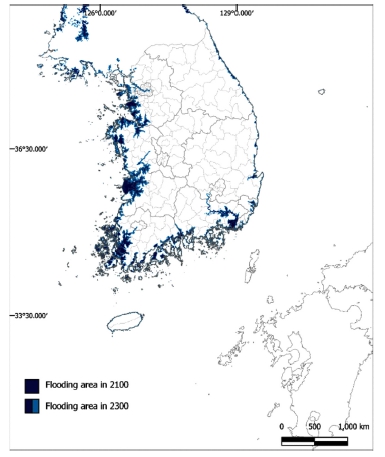
Distribution of flooded areas along the coast of Korea due to sea level rise induced by climate change—in 2100, 1.3 m average sea level rise applied, and in 2300, 5.61 m average sea level rise applied (KMA[2020]; Horton et al.[2020]).
The distribution of victims in flooded areas due to sea level rise is determined with the distribution data of the Korean population extracted from the population distribution of GHSL data (EC JRC and CU CIESIN [2021]) and the distribution data of the flooded area in Fig. 2. The distribution of the Korean population was prepared by clipping the study target areas [124E, 31N] to [132E, 39N] from the population distribution of GHSL data (EC JRC and CU CIESIN[2021]); the distribution in and around flooded areas in 2100 and 2300 is identical to that in Fig. 3. To calculate the number of people in these areas, the grid cell in the form of a raster in the population distribution was vectorized and converted into a grid cell in the form of a square polygon. Population distribution data for each grid cell in the form of a vector were prepared using zonal statistics. In addition, the area ratio of the flooded area was calculated by counting the flooded grid cells of the highly distributed grid cells corresponding to each population distribution grid cell area using the converted grid cell polygon. The number of people in the flooded area was calculated by applying the area ratio of the flooded area to the number of people by population distribution grid cell. In Korea, 669,065 residents and 865,879 residents were at risk due to rising sea levels in 2100 and 2300, respectively.

Distribution of the population of victims in flooded areas along the coast of Korea due to sea level rise induced by climate change in 2100 and 2300 (data source: EC JRC and CU CIESIN [2021]).
The flood damage caused by sea level rise in Korea’s development area is analyzed by using GHSL data (EC JRC and CU CIESIN [2021]) extracted from the distribution of building areas in Korea and the distribution data of the flooded area in Fig. 2. The distribution of flooded areas and surrounding building areas due to sea level rise in Korea in 2100 and 2300 is shown in Fig. 4. The area of flood damage in the Korean development area was calculated as the area of flood damage in the building distribution area. The area of damage in the building distribution area was also calculated with the area of flood damage in the building distribution area. Similar to the analysis of the number of victims of flooded areas, the raster-type building area distribution grid cell was first vectorized and calculated by zonal statistics. Each grid cell’s building area distribution was then analyzed as the area ratio of the flooded area. The area of flood damage in the development area due to the sea level rise in Korea in 2100 was analyzed to be 63 km2, and the damaged area in 2300 increased significantly to 457 km2.

Flooded areas in Korea’s coastal development area due to sea level rise induced by climate change in 2100 and 2300 (Data source: EC JRC and CU CIESIN [2021]).
Flood damage to agricultural and pasture lands in Korea was analyzed by comparing agricultural and pasture lands in Korea based on HYDE 3.2 data (PBL NEAA[2017]) with the distribution data of the flooded area in Fig. 2. Fig. 5 and Fig. 6 visualize the distribution of flooded areas and surrounding agricultural land and pastures due to sea level rise in Korea, respectively, in 2100 and 2300.The area of flooding damage in agricultural land and the area of flooding damage in pasture land were also analyzed on the basis of the ratio of the area distribution of each farmland and pasture in each grid cell calculated by zonal statistics by vectorizing the raster-type building area distribution. The areas of flood damage in agricultural land due to sea level rise in Korea in 2100 and 2300 were analyzed to be 379 km2 and 1,713 km2, respectively. The areas of flood damage in pastures in 2100 and 2300 were analyzed to be 34 km2 and 98 km2, respectively.
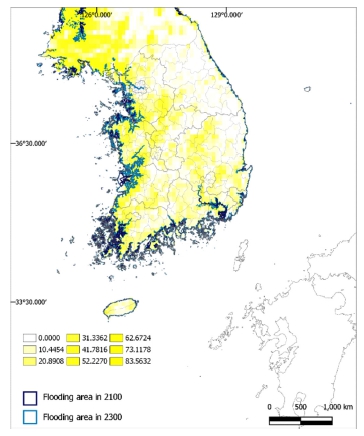
Damaged area of agricultural lands in Korean coastal zones due to sea level rise induced by climate change in 2100 and 2300 (data source: PBL NEAA[2017]).
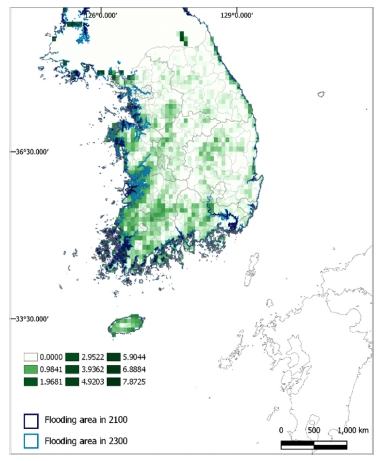
Damaged areas of pastures areas into coastal zones in Korea due to sea level rise induced by climate change in 2100 and 2300 (data source: PBL NEAA [2017]).
The damage caused by sea level rise in Korea by administrative district was performed by comparing the administrative district boundary data of GADM data (UCB MVZ and IRRI [2018]) to the distribution data of the flooded area in Fig. 2. The distribution of flooded areas by administrative district in 2100 and 2300 is indicated in Fig. 7. The flooded areas by administrative district were analyzed separately according to 17 wide-area units of local governments in Korea, eight metropolitan cities with high population density, and nine provinces (considering relatively low population density). In 2100, the flooded area in metropolitan regions due to sea level rise is estimated to be 83 km2, and the area of damage in the provincial area is 789 km2. In addition, the area of flood damage in metropolitan and provincial areas due to sea level rise in 2300 is 339 km2 and 3,876 km2, respectively.
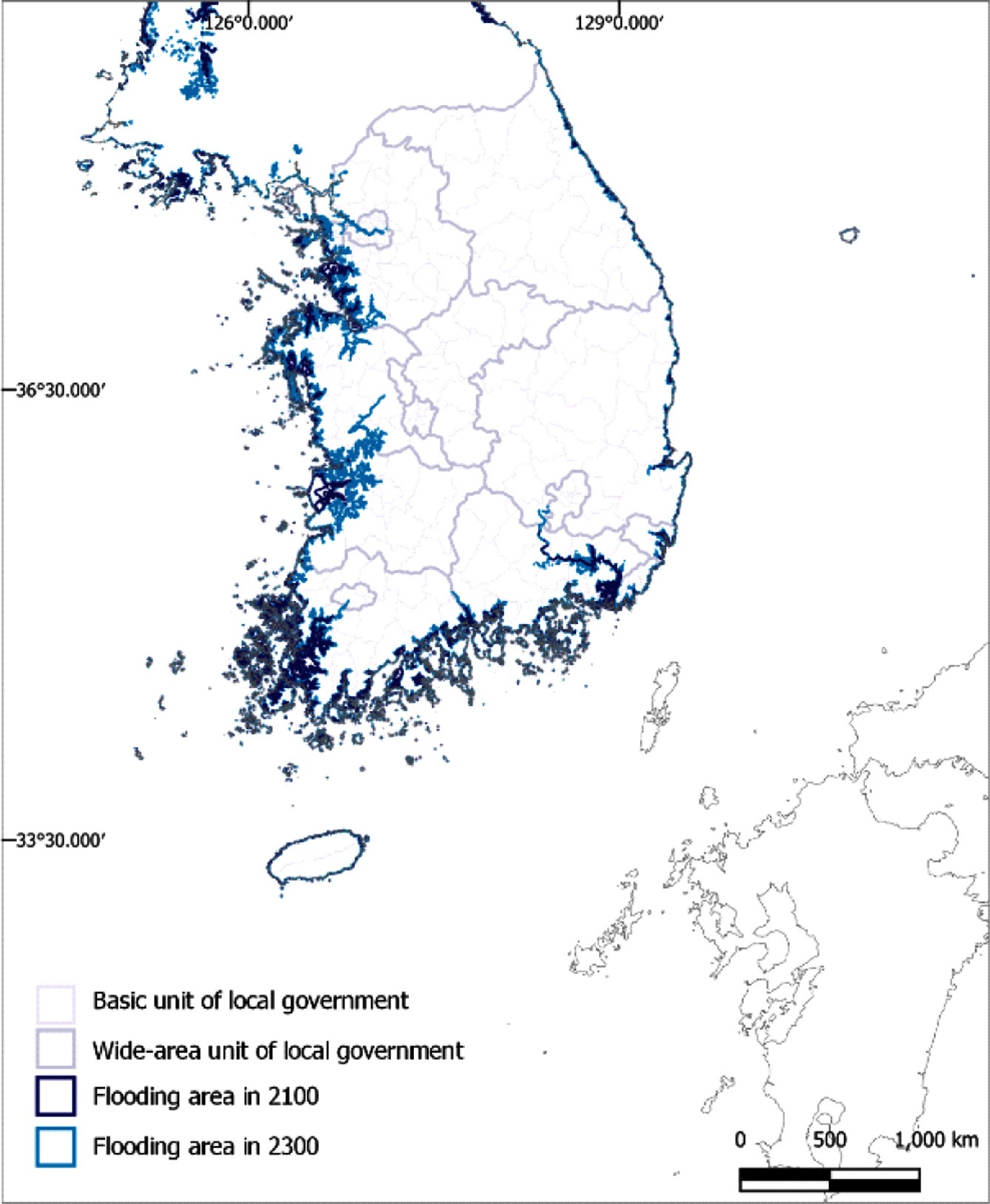
Damaged areas by coastal administrative district by the basic unit of local government in Korea due to sea level rise induced by climate change in 2100 and 2300 (Data source: UCB MVZ and IRRI [2018]).
Damage to Korea’s road network caused by sea level rise was analyzed by comparing the GROADSv1 data (CU CIESIN and UG ITOS [2013]) and the distribution data of flooded areas from Fig. 2. The distribution of road network damage in 2100 and 2300 in Korea is indicated in Fig. 8. The damage was evaluated on the basis of the length of the flooded roads. To this end, a grid cell in the flooded area with a high distribution was converted into a polygon. Only roads not included in the polygon area were extracted by overlapping the polygon and the entire road network. The length of the flooded roads was calculated from the difference between the total road length minus the extracted road length. The damage to Korea’s road network caused by sea level rise in 2100 and 2300 was analyzed to be 47 km and 468 km, respectively.
4. Evaluation of Climate Change Risk in Coastal Environments
To evaluate the risks of the coast of Korea due to climate change, the flooded area along the coast and the number of residents affected by the flooded area were analyzed as basic data. As a damage assessment in urbanized and rural areas, the area of damage in the development area and the area of damage in agricultural and pasture areas were analyzed. As a damage assessment of social overhead capital, the area of damage by administrative district and the length of damaged road in the road network were analyzed.
In the analysis of basic data, the inundation area along the coast was 1,348 km2 due to the 1.3 m increase in average sea level in 2100, and was 5,422 km2 due to the 5.61 m increase in average sea level in 2300. (Table 2). The average sea level in 2100 and 2300 increased by a factor of 4.32, while the flooded damage area increased by a factor of 4.02, which is slightly lower (Table 2). This indicates that the average altitude of the flooded area in 2100 is lower than that of the flooded area in 2300. Therefore, it can be inferred that the slope of the flooded area off the coast of Korea increases from the coast to the inland. The number of victims in flooded areas was 669,065 in 2100 and 3,865,879 in 2300. The number of victims in flooded areas increased by a factor of 5.78 in 2300 compared to 2100, and this growth rate is more extensive than the rate of sea level increase and the rate of flooding damage area increase. This means that the population density of the low-lying coast, which is at a higher risk of flooding, is relatively higher than that of other regions.
In the analysis of damage in urbanized and rural areas, the area of flood damage in urbanized areas due to sea level rise was 63 km2 and 457 km2 in 2100 and 2300, respectively (Table 3). In rural areas, the flood damage in agricultural areas was 379 km2 in 2100 and 1,713 km2 in 2300 (Table 3). In pasture areas in rural areas, the area of flood damage was 34 km2 and 98 km2 in 2100 and 2300, respectively (Table 3). The growth rate of flooded areas in 2300 compared to 2100 in urbanized areas increased by a factor of 4.70 (Table 3). The rate of increase in flooded areas in 2300 compared to 2100 in rural areas rose by a factor of 4.52 in agricultural land and a factor of 2.88 pastures (Table 3). These results indicate that urbanization and agricultural land areas are relatively widely distributed in areas where flooding is expected due to rising sea levels.

Areas of flooded areas and the number of people affected by flooded areas due to sea level rise in 2100 and 2300

Flooded areas in developed areas and rural areas (agricultural land and pasture land) due to rising sea levels in 2100 and 2300
In assessing damage to social overhead capital, flood-affected areas in 2100 due to sea level rise appeared in three out of eight metropolitan cities, with the inundation area being 83 km2 (Table 4). In 2300, the number of affected areas in the metropolitan area increased to six out of eight, and the flooded area was expanded to 339 km2 (Table 4). In 2100, flood-damaged regions in provinces appeared in eight out of nine regions, and the inundation area was 789 km2 (Table 4). In 2300, the affected area in provinces was the same as in 2100, and the area of flood damage was expanded to 3,876 km2 (Table 4). The flood damage to the road network was 47 km in 2100 and 468 km in 2300 (Table 4). The growth rate of flooded areas in 2300 compared to flooded areas in 2100 in metropolitan cities increased by a factor of 4.10, and the growth rate of regions flooded in provinces increased by a factor of 4.91 (Table 4). The damage to the road network was found to increase significantly by a factor of 10.00 in 2300 compared to 2100 (Table 4). This means that provinces are more vulnerable to flooding due to sea level rise than metropolitan cities. In addition, it means that the road network installed on the coast of the lowlands is very vulnerable to flooding caused by sea level rise.

Areas and road inundation length of metropolitan cities and provinces of administrative districts due to sea level rise in 2100 and 2300
There are a total of 229 basic units of local governments split among 17 wide-area units of local governments, 72 of which belong to eight metropolitan areas and 157 of which belong to nine provincial areas. Of the 72 basic units of local government areas belonging to eight metropolitan areas, 21 and 38 are flooded by sea level rise in 2100 and 2300, respectively (Table 5). Of the 157 basic units of local governments belonging to nine provincial areas, 62 and 74 regions are affected by flooding in 2100 and 2300, respectively (Table 5). Observing the 229 basic units of local governments, up to 112 areas are affected by sea level rise in 2300, accounting for 48.9% of Korea’s basic units of local governments. This highlights the vulnerability to flooding for numerous Korean administrative districts due to rising sea levels.
5. Conclusion
The flood damage caused by climate change along the coast of Korea was characterized by a higher rate of increase in the number of victims relative to the increase in sea level in 2100 and 2300. In addition, the flood damage in urbanized and developed areas in the same years was more severe than the increased rate of flood damage in rural areas; among rural areas, agricultural areas exhibited higher flood damage than pasture areas. For the administrative districts, it was found that the district of the provinces had a higher rate of increase in flood damage due to sea level rise than the district of metropolitan areas. In aggregate, 48.9% of Korea’s basic unit of local government regions were vulnerable to flooding due to rising sea levels.
Given the results above, it is evaluated that densely populated and urbanized areas along the Korean coast are more vulnerable due to climate change. In addition, it is found that the regions used as farmland are more susceptible than simple pasturing lands, indicating that residential centers are formed near the coast. This is an overarching phenomenon in the world and has continued due to the concentration of coastal settlements since the 20th century (Moser et al. [2012]; Bennett et al. [2016]). This phenomenon is common in both developed and developing countries (Oppenheimer et al. [2019]) as a result of increasing populations living in the Low Elevation Coastal Zone (LECZ, coastal area of low 10 m of evolution) (Neumann et al. [2015]; Jones and O’Neill [2016]).
Considering the dangers of climate change along the coast of Korea, it is urgent to prepare measures to prevent flood damage. First, moving critical aspects related to human welfare, such as people’s residences, farmland, and road networks, to higher elevations, is becoming increasingly necessary. In addition, 48.9% of Korea’s basic unit of local government areas are vulnerable to flood damage, and thus it is necessary to prepare optimal adaptation measures for each local government along with national countermeasures.
The risk to the coastal environment due to climate change is challenging to define. Epecially, Only flood damage caused by sea level rise and changes in various environmental factors such as water temperature, air temperature, waves, and tides should be considered in combination. As a result, an optimal adaptation plan that is closely interconnected to the natural ecosystem is needed. A more complex risk assessment study is required based on the results of this study, including but not limited to studies in connection with the natural ecosystem. In addition, since sea level rise may occur differently for each region, further studies need to consider this.
References
-
Bennett, N.J., Blythe, J., Tyler, S., and Ban, N.C., 2015, Communities and change in the Anthropocene: understanding social-ecological vulnerability and planning adaptations to multiple interacting exposures. Reg. Environ. Change 16, 907-926.
[https://doi.org/10.1007/s10113-015-0839-5]

- Choi, H.A., Lee, W.K., Kwak, H.B., Choi, S.H., Byun, J.G., Yoo, S.J., and Cui, G., 2009, Climate Change Vulnerability Assessment Based on Spatio-Temporal Information. Korea Spat. Inf. Syst. Society 11, 63-69.
-
Columbia University [CU] Center for International Earth Science Information Network [CIESIN], and University of Georgia [UG] Information Technology Outreach Services [ITOS], 2013, Global Roads Open Access Data Set, Version 1 (gROADSv1). NASA Socioeconomic Data and Applications Center (SEDAC). https://doi.org/10.7927/H4VD6WCT, , 2021 (Accessed 2021.11.07.).
[https://doi.org/10.7927/H4VD6WCT]

- Consultative Group on International Agricultural Research-Consortium for Spatial Information [CGIAR-CSI], 2008, SRTM near global 90m elevation. CGIAR. <https://srtm.csi.cgiar.org/srtmdata/, >, 2021 (Accessed 2021.11.06).
-
European Commission (EC) Joint Research Centre (JRC), and Columbia University (CU) Center for International Earth Science Information Network (CIESIN), 2021, Global Human Settlement Layer: Population and Built-Up Estimates, and Degree of Urbanization Settlement Model Grid. NASA Socioeconomic Data and Applications Center (SEDAC). https://doi.org/10.7927/h4154f0w, , 2021 (Accessed 2021.12.04).
[https://doi.org/10.7927/h4154f0w]

- Giddens, A., 2009, The Politics of Climate Change, Polity Press, Cambridge, UK.
-
Horton, B.P., Khan, N.S., Cahill, N., Lee, J.S.H, Shaw, T.A., Garner, A.J., Kemp, A.C., Engelhart, S.E., and Rahmstorf, S., 2020, Estimating global mean sea-level rise and its uncertainties by 2100 and 2300 from an expert survey, npj Clim Atmos Sci 3:18, <https://doi.org/10.1038/s41612-020-0126-0, >, 2021 (Accessed 2021.11.22).
[https://doi.org/10.1038/s41612-020-0126-0]

- Intergovernmental Panels on Climate Change [IPCC], 2007, Summary for Policymakers, In?Climate Change 2007: The Physical Science Basis. Contribution of Working Group I to the Fourth Assessment Report of the Intergovernmental Panel on Climate Change [Solomon, S., Qin, D., Manning, M., Chen, Z., Marquis, M., Averyt, K.B., Tignor, M. and Miller, H.L. (eds.)]. Cambridge University Press, Cambridge, United Kingdom and New York, NY, USA.
- Intergovernmental Panels on Climate Change [IPCC], 2013, Summary for Policymakers, In: Stocker, T.F., Qin, D., Plattner, G.-K., Tignor, M., Allen, S.K., Boschung, J., Nauels, A., Xia, Y., Bex, V. and Midgley, P.M., editors. Climate Change 2013: The Physical Science Basis, Contribution of Working Group I to the Fifth Assessment Report of the Intergovernmental Panel on Climate Change, Cambridge University Press, Cambridge, UK and New York, USA.
- Intergovernmental Panels on Climate Change [IPCC], 2018, Summary for Policymakers, In: Masson-Delmotte, V., Zhai, P., Pörtner, H.-O., Roberts, D., Skea, J., Shukla, P.R., Pirani, A., Moufouma-Okia, W., Péan, Pidcock, C.R., Connors, S., Matthews, J.B.R., Chen, Y., Zhou, X., Gomis, M.I., Lonnoy, E., Maycock, T., Tignor, M., and Waterfield, T., editors, Global Warming of 1.5℃, An IPCC Special Report on the impacts of global warming of 1.5℃ above pre-industrial levels and related global greenhouse gas emission pathways, in the context of strengthening the global response to the threat of climate change, sustainable development, and efforts to eradicate poverty, World Meteorological Organization, Geneva, Switzerland.
- Intergovernmental Panels on Climate Change [IPCC], 2021, Summary for Policymakers. In: MassonDelmotte, V., Zhai, P., Pirani, A., Connors, S.L., Péan, C., Berger, S., Caud, N., Chen, Y., Goldfarb, L., Gomis, M.I., Huang, M., Leitzell, K., Lonnoy, E., Matthews, J.B.R., Maycock, T.K., Waterfield, T., Yelekçi, O., Yu, R., and Zhou, B., editors, Climate Change 2021: The Physical Science Basis, Contribution of Working Group I to the Sixth Assessment Report of the Intergovernmental Panel on Climate Change, Cambridge University Press, In Press.
-
Jones, B., and O’Neill, B.C., 2016, Spatially explicit global population scenarios consistent with the Shared Socioeconomic Pathways. Environ. Res. Lett. 11:084003, <https://iopscience.iop.org/article/10.1088/1748-9326/11/8/084003, >, 2021 (Accessed 2021.12.08.).
[https://doi.org/10.1088/1748-9326/11/8/084003]

- Kang, I.S., 1994, The Scenario of Temperature Change in Korea Associated with Global Warming (I), J. of the Korean Meteorological Society, 30, 247-260.
- Korea Environment Institute [KEI], 2002, Sea Level Rise and its Possible Impact near the Korea due to Global Warming. Korea Ministry of Environment, Sejong, Korea.
- Korea Hydrographic and Oceanographic Agency [KOHA], 2021, Coastal line of Korea, Public Data Portal (DATA.GO.KR), Ministry of the Interior and Safety. <https://www.data.go.kr/data/15083948/fileData.do, >, 2021 (Accessed 2021.11.21).
- Korea Meteorological Administration [KMA], 2020, Korean Climate Change Assessment Report, Korea Meteorological Administration, Seoul, Korea.
- Korea National Geographic Information Institute [KNGII], 2020, Korean Peninsula Digital Elevation Model 90m, Korea National Spatial Data Infrastructure Portal, Ministry of Land, Infrastructure and Transport, <http://data.nsdi.go.kr/dataset/20001/resource/aa4df3a7-64c9-4640-8b44-8244ac18de49>, 2021 (Accessed 2021.11.21).
-
Lee, H., Kang, T.S., and Cho, K., 2015, Impact Assessment of Sea Level Rise based on Coastal Vulnerability Index, J. of Korean Society of Coast. and Ocean Engineers, 27, 304-314.
[https://doi.org/10.9765/KSCOE.2015.27.5.304]

-
Merkens, J.-L., Reimann, L., Hinkel, J., and Vafeidis, A.T., Gridded population projections for the coastal zone under the Shared Socioeconomic Pathways, Glob. and Planet. Change, 145, 57-66.
[https://doi.org/10.1016/j.gloplacha.2016.08.009]

-
Moser, S.C., Williams, J., and Boesch, D.F., 2012: Wicked challenges at land’s end: managing coastal vulnerability under climate change, Annual Rev. of Environ. and Resources, 37, 51-78.
[https://doi.org/10.1146/annurev-environ-021611-135158]

-
Neumann, B., Vafeidis, A.T., Zimmermann, J., and Nicholls, R.J., 2015, Future Coastal Population Growth and Exposure to Sea-Level Rise and Coastal Flooding - A Global Assessment. PLoS ONE 10:e0118571. <https://doi.org/10.1371/journal.pone.0118571, >, 2021 (Accessed 2021.12.05).
[https://doi.org/10.1371/journal.pone.0118571]

- Oppenheimer, M., Glavovic, B.C., Hinkel, J., van de Wal, R., Magnan, A.K., Abd-Elgawad, A., Cai, R., Cifuentes-Jara, M., DeConto, R.M., Ghosh, T., Hay, J., Isla, F., Marzeion, B., Meyssignac, B., and Sebesvari, Z., 2019, Sea Level Rise and Implications for Low-Lying Islands, Coasts and Communities. In: Pörtner, H.-O., Roberts, D.C., Masso n-Delmotte, V., Zhai, P., Tignor, M., Poloczanska, E., Mintenbeck, K., Alegría, A., Nicolai, M., Okem, A., Petzold, J., Rama, B., Weyer, N.M., editors. IPCC Special Report on the Ocean and Cryosphere in a Changing Climate, In press.
- PBL Netherlands Environmental Assessment Agency [PBL NEAA], 2017, Hyde (History database of the Global Environment), <https://www.pbl.nl/en/image/links/hyde, >, 2021 (Accessed 2021.11.07).
- United Nations [UN], and Canada, 1992, United Nations Framework Convention on Climate Change, United Nations, General Assembly, New York, USA.
- United Nations [UN], 1997, Kyoto Protocol to the United Nations Framework Convention on Climate Change adopted at COP3, United Nations, New York, USA.
- United Nations [UN], 2015, Paris Agreement to the United Nations Framework Convention on Climate Change. United Nations Treaty Collection, New York, USA.
- University of California Berkely [UCB] Museum of Vertebrate Zoology [MVG] and International Rice Research Institute [IRRI] University of California Berkely, 2018, GADM (Global Administrative Areas) maps and data, GADM homepage, <https://gadm.org/, >, 2021 (Accessed 2021.11.10).
